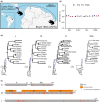Sloths host Anhanga virus-related phleboviruses across large distances in time and space
- PMID: 31420970
- PMCID: PMC7168552
- DOI: 10.1111/tbed.13333
Sloths host Anhanga virus-related phleboviruses across large distances in time and space
Abstract
Sloths are genetically and physiologically divergent mammals. Phleboviruses are major arthropod-borne viruses (arboviruses) causing disease in humans and other animals globally. Sloths host arboviruses, but virus detections are scarce. A phlebovirus termed Anhanga virus (ANHV) was isolated from a Brazilian Linnaeus's two-toed sloth (Choloepus didactylus) in 1962. Here, we investigated the presence of phleboviruses in sera sampled in 2014 from 74 Hoffmann's two-toed (Choloepus hoffmanni, n = 65) and three-toed (Bradypus variegatus, n = 9) sloths in Costa Rica by broadly reactive RT-PCR. A clinically healthy adult Hoffmann's two-toed sloth was infected with a phlebovirus. Viral load in this animal was high at 8.5 × 107 RNA copies/ml. The full coding sequence of the virus was determined by deep sequencing. Phylogenetic analyses and sequence distance comparisons revealed that the new sloth virus, likely representing a new phlebovirus species, provisionally named Penshurt virus (PEHV), was most closely related to ANHV, with amino acid identities of 93.1%, 84.6%, 94.7% and 89.0% in the translated L, M, N and NSs genes, respectively. Significantly more non-synonymous mutations relative to ANHV occurred in the M gene encoding the viral glycoproteins and in the NSs gene encoding a putative interferon antagonist compared to L and N genes. This was compatible with viral adaptation to different sloth species and with micro-evolutionary processes associated with immune evasion during the genealogy of sloth-associated phleboviruses. However, gene-wide mean dN/dS ratios were low at 0.02-0.15 and no sites showed significant evidence for positive selection, pointing to comparable selection pressures within sloth-associated viruses and genetically related phleboviruses infecting hosts other than sloths. The detection of a new phlebovirus closely-related to ANHV, in sloths from Costa Rica fifty years after and more than 3,000 km away from the isolation of ANHV confirmed the host associations of ANHV-related phleboviruses with the two extant species of two-toed sloths.
Keywords: Costa Rica; arbovirus; evolution; penshurt virus; phlebovirus; sloths.
© 2019 The Authors. Transboundary and Emerging Diseases published by Blackwell Verlag GmbH.
Conflict of interest statement
The authors declare no conflict of interest.
Figures

References
-
- Billecocq, A. , Spiegel, M. , Vialat, P. , Kohl, A. , Weber, F. , Bouloy, M. , & Haller, O. (2004). NSs protein of Rift Valley fever virus blocks interferon production by inhibiting host gene transcription. Journal of Virology, 78(18), 9798–9806. 10.1128/JVI.78.18.9798-9806.2004 - DOI - PMC - PubMed
-
- de Moraes‐Barros, N. , Silva, J. A. , Miyaki, C. Y. , & Morgante, J. S. (2006). Comparative phylogeography of the Atlantic forest endemic sloth (Bradypus torquatus) and the widespread three‐toed sloth (Bradypus variegatus) (Bradypodidae, Xenarthra). Genetica, 126(1–2), 189–198. 10.1007/s10709-005-1448-x - DOI - PubMed
MeSH terms
Substances
Associated data
- Actions
- Actions
- Actions
- Actions
- Actions
- Actions
- Actions
- Actions
- Actions
- Actions
- Actions
- Actions
- Actions
- Actions
- Actions
- Actions
- Actions
- Actions
- Actions
- Actions
- Actions
- Actions
- Actions
- Actions
- Actions
- Actions
- Actions
- Actions
- Actions
- Actions
- Actions
- Actions
- Actions
- Actions
- Actions
- Actions
- Actions
- Actions
- Actions
- Actions
- Actions
- Actions
- Actions
- Actions
- Actions
- Actions
- Actions
- Actions
- Actions
- Actions
- Actions
- Actions
- Actions
- Actions
- Actions
- Actions
- Actions
- Actions
- Actions
- Actions
- Actions
- Actions
- Actions
- Actions
- Actions
- Actions
Grants and funding
LinkOut - more resources
Full Text Sources
Molecular Biology Databases

